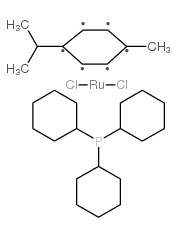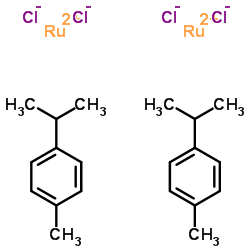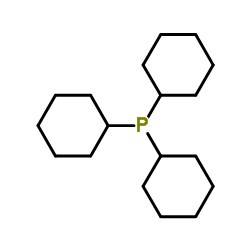Dichloro(p-cymene)tricyclohexylphosphineruthenium(II)
Modify Date: 2024-01-01 19:11:24

Dichloro(p-cymene)tricyclohexylphosphineruthenium(II) structure
|
Common Name | Dichloro(p-cymene)tricyclohexylphosphineruthenium(II) | ||
|---|---|---|---|---|
| CAS Number | 145381-23-3 | Molecular Weight | 586.62300 | |
| Density | N/A | Boiling Point | 383.4ºC at 760 mmHg | |
| Molecular Formula | C28H47Cl2PRu | Melting Point | N/A | |
| MSDS | N/A | Flash Point | 195.6ºC | |
| Name | dichlororuthenium,1-methyl-4-propan-2-ylbenzene,tricyclohexylphosphane |
|---|---|
| Synonym | More Synonyms |
| Boiling Point | 383.4ºC at 760 mmHg |
|---|---|
| Molecular Formula | C28H47Cl2PRu |
| Molecular Weight | 586.62300 |
| Flash Point | 195.6ºC |
| Exact Mass | 586.18400 |
| PSA | 13.59000 |
| LogP | 10.48750 |
| Vapour Pressure | 9.7E-06mmHg at 25°C |
|
Section 1: Product Identification Chemical Name:Dichloro(p-cymene)tricyclohexylphosphineruthenium (II), min. 97% CAS Registry Number:145381-23-3 Formula:RuCl2(C10H14)P(C6H11)3 EINECS Number:none Chemical Family:metal phosphine complex Synonym:tricyclohexylphosphine(p-cymene)ruthenium dichloride
Section 2: Composition and Information on Ingredients IngredientCAS NumberPercentACGIH (TWA)OSHA (PEL) Title compound145381-23-3100%no datano data Section 3: Hazards Identification Emergency Overview:Irritating to the respiratory tract, skin and eyes. May be harmful if swallowed. Primary Routes of Exposure:Inhalation, skin, eyes Eye Contact:Causes slight to mild irritation of the eyes. Skin Contact:Causes slight to mild irritation of the skin. Inhalation:Dust is irritating to the nose, mucous membranes and respiratory tract. Ingestion:No specific information is available on the physiological effects of ingestion. May be harmful if swallowed. Acute Health Affects:Irritating to skin, eyes and respiratory tract. May be harmful if swallowed. Chronic Health Affects:No information available on long-term chronic effects. NTP:No IARC:No OSHA:No SECTION 4: First Aid Measures Immediately flush the eyes with copious amounts of water for at least 10-15 minutes. A victim may need Eye Exposure: assistance in keeping their eye lids open. Get immediate medical attention. Wash the affected area with soap and water. Remove contaminated clothes if necessary. Seek medical Skin Exposure: assistance if irritation persists. Remove the victim to fresh air. Closely monitor the victim for signs of respiratory problems, such as difficulty Inhalation: in breathing, coughing, wheezing, or pain. In such cases seek immediate medical assistance. Seek medical attention immediately. Keep the victim calm. Give the victim water (only if conscious). Induce Ingestion: vomiting only if directed by medical personnel. SECTION 5: Fire Fighting Measures Flash Point:no data Autoignition Temperature:no data Explosion Limits:no data Extinguishing Medium:carbon dioxide, dry powder or foam If involved in a fire, fire fighters should be equipped with a NIOSH approved positive pressure self-contained Special Fire Fighting Procedures: breathing apparatus and full protective clothing. Hazardous Combustion andIf involved in a fire this material may emit irritating fumes. Decomposion Products: Unusual Fire or Explosion Hazards: No unusual fire or explosion hazards. SECTION 6: Accidental Release Measures Spill and Leak Procedures:Small spills can be mixed with vermiculite or sodium carbonate and swept up. SECTION 7: Handling and Storage Handling and Storage:Store the material in a cool, dry, well ventilated place in a tightly sealed container. SECTION 8: Exposure Controls and Personal Protection Eye Protection:Always wear approved safety glasses when handling a chemical substance in the laboratory. Skin Protection:Wear protective clothing and gloves. Ventilation:If possible, handle the material in an efficient fume hood. If ventilation is not available, a respirator should be worn. The use of respirators requires a Respiratory Respirator: Protection Program to be in compliance with 29 CFR 1910.134. Ventilation:If possible, handle the material in an efficient fume hood. Additional Protection:No additional protection required. SECTION 9: Physical and Chemical Properties Color and Form:orange powder Molecular Weight:586.62 Melting Point:no data Boiling Point:no data Vapor Pressure:no data Specific Gravity:no data Odor:none Solubility in Water:insoluble SECTION 10: Stability and Reactivity Stability:air and moisture stable Hazardous Polymerization:No hazardous polymerization Conditions to Avoid:Very strong oxidizing agents such as nitric acid may produce toxic volatile ruthenium tetroxide. Incompatibility:oxidizing agents, halogens and active metals Decomposition Products:carbon dioxide, carbon monoxide, organic fumes, phosphorus oxides, and ruthenium chloride. SECTION 11: Toxicological Information RTECS Data:No information available in the RTECS files. Carcinogenic Effects:no data Mutagenic Effects:no data Tetratogenic Effects:no data SECTION 12: Ecological Information Ecological Information:No information available SECTION 13: Disposal Considerations Disposal:Dispose of according to federal, state and local regulations. SECTION 14: Transportation Shipping Name (CFR):Non-hazardous Hazard Class (CFR):NA Additional Hazard Class (CFR):NA Packaging Group (CFR):NA UN ID Number (CFR):NA Shipping Name (IATA):Non-hazardous Hazard Class (IATA):NA Additional Hazard Class (IATA):NA Packaging Group (IATA):NA UN ID Number (IATA):NA SECTION 15: Regulatory Information TSCA:Not listed in the TSCA inventory SARA (Title 313):Title compound not listed Second Ingredient:none SECTION 16 - ADDITIONAL INFORMATION N/A |
|
~90% 
Dichloro(p-cyme... CAS#:145381-23-3 |
| Literature: Buchmeiser, Michael R.; Wang, Dongren; Zhang, Yan; Naumov, Sergej; Wurst, Klaus European Journal of Inorganic Chemistry, 2007 , # 25 p. 3988 - 4000 |
| Precursor 2 | |
|---|---|
| DownStream 0 | |
| MFCD06798308 |

